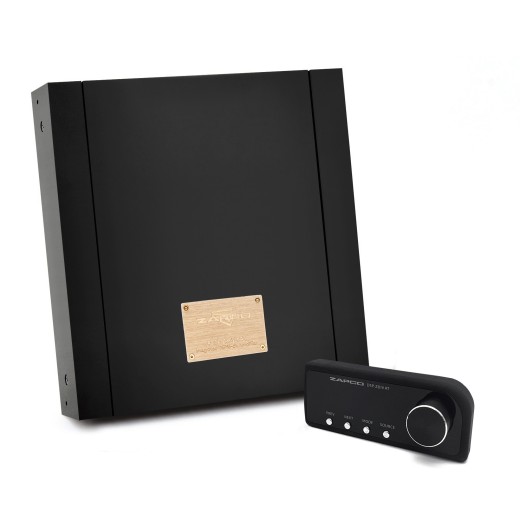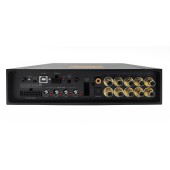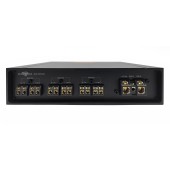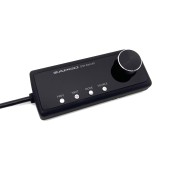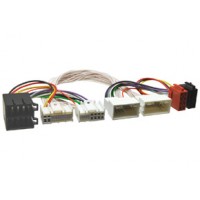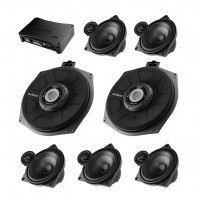Amplifier with DSP processor Zapco ADSP-Z8 IV-6AT
More about the product
- Use our consulting room
- You can return the goods to us within 14 days
- Try the product at our store
Amplifier with DSP processor Zapco ADSP-Z8 IV-6AT
Many years ago, Zapco introduced their DSP-Z8 IV DSP processor. It was designed to bring true audiophile sound quality to an affordable DSP. The Zapco DSP-Z8 IV was a real giant killer, delivering sound quality better than units costing twice as much. But as Zapco has always said and will always say, "We believe we can do better". First introduced in 2018 was the updated DSP-Z8 IV II series, which brought a number of improvements, and in 2022 we saw the all-new Zapco DSP-Z8 IV AT model series, which includes two new DSP processors, two DSP processor amplifiers and a digital monobloc. And what's new with the IV AT series? New features, new controls and of course even better sound. The unified look of the Black and Copper theme of the Zapco AP Series audiophile amplifiers is just the beginning.
New features of the Zapco ADSP-Z8 IV-6AT amplifier
Compared to its predecessor, the Zapco ADSP-Z8 IV-6AT amplifier lost two channels and now offers a total of six channels with a power of 80 W RMS per channel at 4 Ohms. The amplifier is stable up to 2 Ohms and the channels can also be bridged. Newly, the amplifier has a total of 8 high-level inputs, 8 low-level RCA inputs and 2 RCA outputs are also new. The new coaxial and optical inputs accept a digital signal from the head unit or a portable HD player. Also new is the option to set the level of the input signal, improved PC software, the possibility of automatic calibration using an optional microphone, and especially the optional Bluetooth module for streaming music in Hi-Res quality. Also new is the remote control, which will allow you to change the input source, control the main volume or amplifier output for the subwoofer and even switch songs when playing music from, for example, a mobile application.
The main features of the Zapco ADSP-Z8 IV-6AT amplifier
- 6-channel class D amplifier with integrated DSP processor.
- Power 6 x 80 W RMS (4 Ω), 8 x 120 W RMS (2 Ω).
- Power in the bridge at 4 Ω: 3 x 240 W RMS.
- DSP Processor: Cirrus Logic CS47048.
- ADC: Cirrus Logic CS47048 32 bit/192 KHz.
- ADC Dynamic Range/THD: 108dB/-98dB.
- DAC: Cirrus Logic CS8422 24 bit/192 KHz.
- DAC Dynamic Range/THD: 140dB/-120dB.
- Outputs: 8 x RCA, 8 x high-level, 1 x optical, 1 x coaxial.
- Outputs: 2 x RCA.
- Automatic sound calibration function.
- Remote control included in the package.
- Stream music in high definition via the optional Zapco HD-BT module.
Enhanced PC software
The new Zapco ADSP-Z8 IV-6AT amplifier gives you the great sound and functionality of the Series IV II and adds a coaxial digital input as well as an optical digital input and Bluetooth streaming capability. However, the PC software also saw several improvements. The drop-down menus now allow you to name each output channel to match your system settings. The added Advanced menu also includes new Mixing Set and AutoTune features. The new DSP-Z8 IV AT gives you more options for input selection. You can have up to 8 input channels which you can instantly set up simply by selecting 2-Ch, 4-Ch, 6-Ch or 8-Ch in the inputs section on the front. If you need to sum the channels of the factory stereo to get the full range of the input, just click SUM and the system will do it all for you. But if your system is more complex, you also have the option to go into the Advanced menu and use Mixing Set to manually assign each channel exactly the amount of input from each input channel that will work best for your particular audio setup.
Automatic sound calibration
DSP IV AT series processors now give you automatic calibration for signal EQ, phase and delay, when you purchase the optional Zapco calibrated microphone. You can choose which function you want the system to calibrate, as well as which channels you want to include in the calibration. In the graph area you can see how the system is currently working and you can also look at the equalization curves of the speakers. Calibration of all channels within all functions is done automatically within 5 to 10 minutes, saving you several hours of time. Of course, the human ear will always be the final judge, but auto-tune will get you to the point where you can just make the final adjustments and enjoy the music.
About the Zapco brand
Zapco is the oldest high-end car audio brand in the world, specializing in high-end car amplifiers and DSP processors. The company was founded in the USA back in 1974 and has been collecting one award after another since then. And this both from prestigious organizations that evaluate the quality of products and innovations, as well as at global competitions focused mainly on sound quality. Zapco amplifiers represent audiophile quality without compromise, defining the standard of quality and setting the criteria by which other products in the industry are judged. At Zapco, for over 45 years, they have been constantly looking for innovative ways to bring better sound to the automotive environment, and this relentless pursuit of absolute sound quality has always resulted in new technologies and high-end products. Are you asking why? Because nothing else can capture the soul and bring tears to the eyes like music. Music can make you dance for joy..... of all the arts, music has the most powerful and immediate effect on your body and mind. Reproducing music in all its beauty and delicacy deserves nothing less than the best efforts of all Zapco employees. And also because music matters!
| Catalog number | ADSP-Z8 IV-6AT |
| Brand | Zapco |
| Links | Official web presentation (English) |
| Number of amplifier channelsAmplifiers are divided into: - Monoblocks - 2-channel - 3-channel - 4-channel - 5-channel - 6-channel - multi-channel Each channel is used to power one speaker for the coaxial type, or one side if they are component speakers. Monoblock type amplifiers are mainly used for subwoofers. 2-channel are suitable for both subwoofers and, for example, the front pair of speakers in a car. 3-channel is used for front or rear speakers + subwoofer. 4-channel are used for front + rear speakers or 1 pair of speakers + subwoofer. 6 or 5-channel are used for 2 pairs of speakers + subwoofer, most often. Bridging means connecting the amplifier to a bridge, using the + pole from one channel and the - pole from the other channel. In most cases this is shown as "BRIDGED" on the amplifier. | 6 |
| Energy class of the amplifierAmplifiers are divided into two basic classes: analog and digital . Analog amplifiers (A/B) have higher consumption requirements, but usually have a more natural sound. Digital amplifiers (D) have significantly lower consumption and higher efficiency, but the sound may not be as faithful as with classic analog amplifiers. | D |
| RMS power into 4 ΩRMS power when loading speakers or subwoofer at 4 Ω. RMS power is the constant power of the amplifier and is one of the most important parameters when choosing an amplifier. | 6 x 80 W / 3 x 240 W |
| RMS power into 2 ΩRMS power when loading speakers or subwoofer at 2 Ω. RMS power is the constant power of the amplifier and is one of the most important parameters when choosing an amplifier. | 6 x 120W |
| Frequency rangeThe ability of the amplifier to reproduce the signal from the lowest frequency to the highest = faithfully reproduce the sound in a specific frequency band. Professionally: In the frequency range from 40 to 16,000 Hz, the vast majority of fundamental and overtones (harmonics) of all musical instruments are found. We are interested in the course of the radiated sound pressure in this range of frequencies when the loudspeaker system is supplied with constant power. We call this course the frequency characteristic, which tells us the level of radiated sound pressure in decibels (dB) depending on the frequency. The frequency characteristic of a speaker or speaker system can be expressed most succinctly with a graph. Mostly, however, the frequency characteristic is indicated by indicating the maximum tolerance of the sound pressure in the given frequency range, e.g. 50 to 15,000 Hz -+ 6 dB. Since the frequency characteristics of loudspeakers and systems in general are quite uneven, some manufacturers do not even specify this maximum tolerance of sound pressure in decibels in their catalogs for reasons of prestige. Data impoverished in this way is unfortunately worthless. What is valid is that the manufacturer offers a speaker system with a frequency range of 30 to 20,000 Hz, if he is worried about stating the maximum unevenness of the sound pressure in this range, because he can have a tolerance of, for example, +- 20 dB. The unevenness or undulation of the frequency curve in good speaker systems for high-quality music performance should not exceed +-3 dB in the 80 to 12,000 Hz band and +-6 dB in the 40 to 16,000 Hz band. Greater unevenness already depletes or emphasizes certain tonal areas, which can cause audible or even disturbing distortion. The proportion between fundamental tones and higher harmonics also changes, thereby changing the color of the sound, and individual musical instruments as well as the entire musical image sound unnatural. | 10 - 22500 Hz |
| Harmonic Distortion (THD)Total harmonic distortion indicates how much the input signal is distorted in the amplifier. Distortions appear as overtones contained in the output signal. The proportion of originally absent parts of the signal is given as a percentage, typical values are between 0.001% and 0.5%. Distortion is measured in their power band. If it exceeds the limit of 0.7% from a certain power, it is the value of the output power of the given amplifier, from which it no longer plays without distortion and from which the distortion usually increases steeply, so that no further increase in power can be counted on. The lower the value, the better. | 0.002% |
| Signal-to-noise ratioThe signal-to-noise ratio means that the output signal always contains noise. The signal-to-noise ratio expresses how much of this noise is compared to the useful signal. The so-called A value is given, which does not take deep and very high frequencies into account. This corresponds to the characteristic of human hearing, which is not so sensitive to deep frequencies, especially below 1 kHz. The higher the value, the better the amplifier is. | 110 dB |
| High level inputsThe high-level input on the amplifier allows connection directly to the existing speakers in the car without additional purchase of an external high/low adapter. Important equipment in the case of installing an amplifier on an original car radio. | Yes |
| Automatic on and offThis function allows you to automatically switch on the amplifier. | Yes |
| Socket input terminalsFerrule terminals allow better wiring contact to the amplifier. It is also a more secure form of terminals. If you are tightening the sleeve terminals, we recommend retightening them after 1 day, as the connected cable gradually compresses. | Yes |
| Remote control included in the packageSome models of amplifiers also come with wired remote controls in the package, which on one side plug into the amplifier and on the other side you have a potentiometer that you can place anywhere in the cabin. A common place to place the remote control is under the steering wheel. The advantage is the regulation of power, and therefore volume, depending on driving conditions and the mood of the crew in the car. | Yes |
| Dimensions of the amplifier | 222 x 230 x 52 mm |
